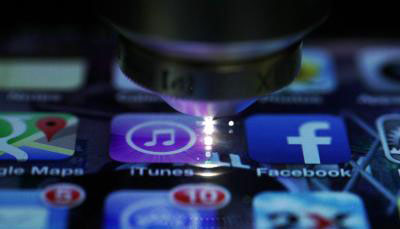| Posted: Jun 18, 2014 |
Making smartphones smarter with see-through sensors
|
|
(Nanowerk News) Your smartphone's display glass could soon be more than just a pretty face, thanks to new technology developed by researchers from Montreal and the New York-based company Corning Incorporated. The team has created the first laser-written light-guiding systems that are efficient enough to be developed for commercial use. They describe their work in a paper published today in The Optical Society's (OSA) open-access journal, Optics Express ("Making smart phones smarter with photonics").
|
 |
| An invisible waveguide (pathway for light) being written via laser into a smartphone's display glass is shown. The waveguide is a horizontal line from the left side of the screen, but it cannot be seen with the naked eye.
|
|
This revolutionary work could open up new real estate in the phone by embedding the glass with layer upon layer of sensors, including ones that could take your temperature, assess your blood sugar levels if you're diabetic or even analyze DNA.
|
|
The researchers have used their new technology to build two completely transparent systems—a temperature sensor and a new system for authenticating a smartphone using infrared light—into a type of glass that's currently used in most smartphones.
|
|
In addition to biomedical sensors, the technology could also eventually allow computing devices to be embedded into any glass surface, such as windows or tabletops, creating the transparent touchscreens seen in movies like Avatar and Iron Man, the researchers say.
|
|
"We're opening the Pandora's box at the moment," says paper co-author Raman Kashyap, a professor of electrical engineering and engineering physics at Polytechnique Montreal in Canada. Now that the technique is viable, "it's up to people to invent new uses" for it, he says.
|
|
To make their see-through temperature-sensing and phone-authentication systems, the researchers turned to photonics. While electronic devices transmit information via electrons, photonic devices use light. The researchers used lasers to carve out transparent pathways called waveguides into the glass. These waveguides act as tunnels that channel light, analogous to the way electronic wires convey electrical signals, and form the basis for a host of applications.
|
|
Although people have used lasers to make photonic waveguides before, this is the first time anyone has applied the technique to Gorilla® Glass, a tough glass with high internal stress and low irregularity, developed by Corning that's now used in billions of electronic devices.
|
|
According to first author Jerome Lapointe of Polytechnique Montreal, this new photonic waveguide is the best that's ever been made using lasers. While no waveguide is perfect—light will inevitably leak out due to imperfections—the new waveguides created by the team are 10 times better at minimizing such loss than previous ones made with lasers, he says. And because Gorilla Glass has greater internal stress and less irregularities than other types of glass, the waveguides are smoother and better at preventing light from escaping. This also means the researchers can use lower energy ultra-short laser pulses at a high repetition rate, which results in smoother and more efficient waveguides.
|
|
Current techniques such as photolithography—which uses light-sensitive chemicals to etch or deposit material—are very good at minimizing light loss, but the team's laser method is cheaper and simpler, Lapointe says. Also, photolithography restricts waveguides to the surface of the glass. But using lasers enables researchers to make waveguides at any depth, allowing them to create many applications, one on top of each other, like layers in a cake. Layering the waveguides within the glass itself paves the way for more compact devices, which means you could squeeze more apps into your phone.
|
|
|
|
Temperature Sensors and Secure Transactions
|
|
To demonstrate their technique, the researchers built a standard type of temperature sensor that consists of a straight and a curved waveguide. When the glass heats up, it expands and changes the path length of the waveguides. By measuring how the light that emerges from one waveguide interferes with light from the other, the device can measure temperature – yours or that of anything it touches.
|
|
The researchers also developed a new method for authenticating a smartphone based on waveguides with holes at various locations. The light that escapes through those holes creates a pattern that is unique to their arrangement. The idea is that each phone would have its own unique pattern, like a fingerprint, which could then be read by an infrared detector to confirm the identity of the phone as an additional layer of security for making financial transactions using smartphones. Such transactions could be relatively safe because instead of using radio frequency they use infrared light, which is blocked by most materials and therefore cannot be copied through a pocket or purse.
|
|
Both the temperature sensor and authentication system are being patented and the team is hoping to optimize them for use in consumer devices.
|
|
"We are actively looking to partner with industry to exploit this technology," Kashyap says. With focused development, he adds, the two systems could potentially be integrated commercially into smartphones within a year.
|

